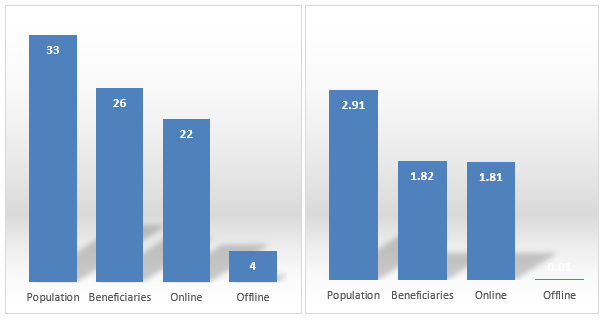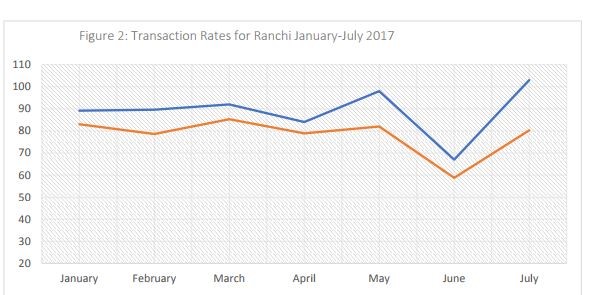Aadhaar-based biometric authentication was made mandatory for obtaining rations under the Public Distribution System in Ranchi district in Jharkhand in August 2016. In this article, Nazar Khalid demonstrates that even a year later, a significant fraction of cardholders is still unable to buy their foodgrain rations.
The debate over the merits of imposing Aadhaar-Based Biometric Authentication (ABBA) on various welfare programmes is far from over.1 Several states have already gone ahead with this in the Public Distribution System (PDS). In Jharkhand, ABBA was made mandatory for PDS rations in Ranchi district in August 2016, and then gradually extended across the state.
How Aadhaar-Based Biometric Authentication works
As part of this transition, the distribution of monthly foodgrain rations (mainly rice) at Fair Price Shops (FPSs) is now digitised using electronic Point of Sale (PoS) machines. The PDS dealers are no longer required to maintain records of sales and stock, as these are electronically maintained by the PoS machine which also generates receipts of the transactions for the beneficiaries.
In this new online system, a beneficiary is entitled to buy their monthly quota contingent on the matching of their fingerprint, at the time of transaction through PoS, with the biometrics stored against their Aadhaar number in the Central Identities Data Repository (CIDR). In case of authentication failure, that is, when the matching is unsuccessful, an alternative authentication facility based on a one-time password (OTP) is available. This facility, however, requires the beneficiary to have a mobile phone number, correctly entered in the system.
For a household to buy its monthly foodgrain ration, it is enough for one member to authenticate himself or herself. Even then, transaction failures are common in Jharkhand. The main reason is that authenticating oneself involves several hurdles: correct “seeding” of one’s Aadhaar number in the system, fingerprint recognition, good connectivity, and so on.
This system is internet-based. An ‘offline’ variant, not requiring biometric authentication, is in place in areas that have poor connectivity. In Ranchi district, however, the online version applies since August 2016. This is a good opportunity to examine how ABBA works in practice, bearing in mind that Ranchi district has relatively good connectivity and infrastructure, by Jharkhand standards.
Success rate of online PDS transactions
The transaction records generated by PoS machines are publicly available on the Jharkhand government’s PDS “aahar” website (http://aahar.jharkhand.gov.in/). This well-designed website presents rich information on many aspects of the PDS such as the lists of beneficiaries, monthly foodgrain allocations, details of dealers, and progress of Aadhaar seeding. It also makes it possible to file complaints online and track their status.
The importance of the PDS for Jharkhand can hardly be overstated. More than three-quarters of the state’s residents are eligible for PDS rations. Figure 1 shows the beneficiary coverage and its distribution between online and offline systems for Ranchi district and Jharkhand as a whole. As can be seen, the proportion of beneficiaries covered by the online system is around 84% in Jharkhand as a whole, and close to 100% in Ranchi district.
Figure 1. PDS coverage and distribution in Ranchi district (right) and Jharkhand (left), in millions
Transaction records for Ranchi district can be used to estimate the success rate of PDS transactions in the online system (hereafter ‘transaction rates’). Figure 2 presents two types of transaction rates. The “count transaction rate” (CTR) is simply the proportion of cardholders who were able to buy their foodgrain rations in a particular month2. The “quantity transaction rate” (QTR) is the quantity of grain distributed (according to digital records) as a proportion of the total amount due to PDS beneficiaries. The transaction rates have been calculated from January 2017 onwards: prior to that, there are anomalies in the records, possibly due to teething problems with the online system.
Figure 2 must be read bearing in mind that PDS distribution in Jharkhand is not always timely everywhere. Sometimes, food rations for one month are distributed the following month in some areas. This may help, for instance, to explain the distribution dip in April in Ranchi district, followed by a surge in May, with a similar pattern again in June-July. Our main interest, in this article, is with averages over the reference period rather with month-to-month variations.
Figure 2. Transaction rates for Ranchi, January-July 2017
The QTR hovered around 90% from January to April, with larger month-to-month variations after that, possibly due to delays or disruptions in the supply chain (the average over seven months is 89%). Note that nothing prevents the QTR from reaching or even exceeding 100% in any given month: the reason is that, when beneficiaries are unable to buy their food rations in a particular month, they are allowed double rations the next month. The CTR was around 80% throughout the reference period, except in June when it was as low as 59%.
The CTR is lower than the QTR throughout. This gap seems to be due to two factors. The double quantity transactions, mentioned earlier, account for some of it. However, another plausible explanation is that transacting households (those that are able to buy their foodgrain rations) tend to be larger, on average, than non-transacting households. The reason for this is that a larger household has a better chance of successful biometric authentication as more members are available to try their luck. The smaller households, including vulnerable sections of the society such as elderly couples and widows living alone, are at greater risk of authentication failure and being left out of the PDS – this has been widely noted in earlier media reports and field surveys. Since transacting households are larger, and have larger food entitlements (these are normally calculated on a per-capita basis under the National Food Security Act), the QTR tends to be higher than the CTR.
The CTR estimates indicate that about 20% of cardholders in Ranchi district were unable to transact in an average month during the reference period. In absolute terms, a transaction failure rate of 20% would mean that about 81,000 cardholders are unable to buy their PDS rations in Ranchi district alone (there are 407,000 ration cardholders in the district).3 This must be read in the light of the fact that some of them would have been able to ‘make up’ for it by buying double the normal quantity in the following month. It is very difficult to estimate from official data how many people do this in Ranchi district, as it requires matching purchases and entitlements household-wise. I did this for a random sample of 20 villages (one in each block of Ranchi district), but using data from September 2017 because the PDS website now displays digital transaction records for the previous two months only. In these 20 villages, only 4% of cardholders had purchased double quantities in September 2017.
Further, digital records may exaggerate the actual incidence of double-quantity transactions. Indeed, when a cardholder is not clear about the two-months window facility, it is quite easy for a dealer to record a double transaction in the PoS machine in the second month (if the cardholder failed to transact the previous month) while giving him or her a single month’s ration. In a recent survey of PDS in 32 randomly-selected villages of Jharkhand (Drèze et al. 2017), barely half of the respondents were aware of the two-months window facility.
The QTR may seem like a more informative indicator of transaction rates than the CTR. However, the QTR is an overestimate of actual foodgrain distribution. The main reason is that dealers are known to take unrecorded cuts (known as ‘katauti’) from people’s foodgrain rations. In the survey mentioned earlier, cuts varied between 0% and 20%, with an average of 7%.
While ABBA-related issues may not be entirely responsible for high failure rates, there exists evidence to suggest that they do account for a significant proportion of transaction failures. For example, in the same survey, more than 40% of non-transacting households explicitly cited ABBA-related issues as the reason for them not being able to purchase their monthly quota in the month preceding the survey (May 2017).4 Another important clue is that transaction failure rates were about five times as high in online areas compared with offline areas.
The success of ABBA depends on the simultaneous functioning of undependable technologies such as the PoS machine, remote Aadhaar servers, fingerprint recognition devices, and internet connectivity.5 The analysis of digital records, along with independent survey data, provides us with some important insights on the impact of the new system on the PDS in Jharkhand, and it’s only in the combination of digital records and the survey data, such as Drèze et al. (2017), that a clearer picture emerges. Even in Ranchi district, a relatively ‘favourable environment’ for these technologies to function, the failure rates are considerable. This raises serious questions about the appropriateness of this technology for the PDS, especially in areas like rural Jharkhand.
This analysis was undertaken in September 2017 based on digital records available at that time. There are doubts about the credibility of digital records after July 2017, when the PDS in Jharkhand was disrupted by the government's attempt to recover from PDS dealers the stocks that had accumulated by then as a result of transaction failures (see Drèze et al. 2017).
Notes:
- Aadhaar or Unique Identification number (UID) is a 12-digit individual identification number issued by the Unique Identification Authority of India (UIDAI) on behalf of the Government of India. It captures the biometric identity – 10 fingerprints, iris and photograph – of every resident, and serves as a proof of identity and address anywhere in India.
- In calculating CTR, I have made adjustments to exclude White cards. White cards, meant for well-off households, are not relevant to this analysis because they carry no foodgrain entitlements (though they are valid for kerosene).
- A similar failure rate in Jharkhand as a whole would imply that 1,120,000 cardholders and their families are effectively excluded from the PDS. Failure rates may be higher in other districts due to poor connectivity, although the offline option would mitigate this problem.
- Brief case studies of some of these households can be found at https://drive.google.com/file/d/0B5KV7ezRQxCFM1hkMjlLX3UyMU0/view
- ABBA-related problems are not specific to PDS. Abraham et al. (2017) find that biometric authentication failures are high (14.4% and 17.4% for iris and fingerprints, respectively, in Andhra Pradesh) among recipients of MNREGA (Mahatma Gandhi National Rural Employment Guarantee Act) wages and social security pensions. Among MNREGA workers in Telangana the failure rates are 7% and 7.8% respectively.
Further Reading
- Abraham, R, E Bennett, N Sen, and NB Shah (2017), ‘State of Aadhaar Report 2016-2017’, IDInsight. Available at http://stateofaadhaar.in/wpcontent/uploads/Stateof-Aadhaar-Full-Report-2016-17-IDinsight.pdf
- Drèze, Jean, Nazar Khalid, Reetika Khera, and Anmol Somanchi (2017), “Aadhaar and Food Security in Jharkhand: Pain without Gain?”, Economic and Political Weekly, Vol. LII(50).




 10 January, 2018
10 January, 2018 






Comments will be held for moderation. Your contact information will not be made public.